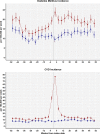Cardiometabolic outcomes up to 12 months after COVID-19 infection. A matched cohort study in the UK
- PMID: 35853019
- PMCID: PMC9295991
- DOI: 10.1371/journal.pmed.1004052
Cardiometabolic outcomes up to 12 months after COVID-19 infection. A matched cohort study in the UK
Abstract
Background: Acute Coronavirus Disease 2019 (COVID-19) has been associated with new-onset cardiovascular disease (CVD) and diabetes mellitus (DM), but it is not known whether COVID-19 has long-term impacts on cardiometabolic outcomes. This study aimed to determine whether the incidence of new DM and CVDs are increased over 12 months after COVID-19 compared with matched controls.
Methods and findings: We conducted a cohort study from 2020 to 2021 analysing electronic records for 1,356 United Kingdom family practices with a population of 13.4 million. Participants were 428,650 COVID-19 patients without DM or CVD who were individually matched with 428,650 control patients on age, sex, and family practice and followed up to January 2022. Outcomes were incidence of DM and CVD. A difference-in-difference analysis estimated the net effect of COVID-19 allowing for baseline differences, age, ethnicity, smoking, body mass index (BMI), systolic blood pressure, Charlson score, index month, and matched set. Follow-up time was divided into 4 weeks from index date ("acute COVID-19"), 5 to 12 weeks from index date ("post-acute COVID-19"), and 13 to 52 weeks from index date ("long COVID-19"). Net incidence of DM increased in the first 4 weeks after COVID-19 (adjusted rate ratio, RR 1.81, 95% confidence interval (CI) 1.51 to 2.19) and remained elevated from 5 to 12 weeks (RR 1.27, 1.11 to 1.46) but not from 13 to 52 weeks overall (1.07, 0.99 to 1.16). Acute COVID-19 was associated with net increased CVD incidence (5.82, 4.82 to 7.03) including pulmonary embolism (RR 11.51, 7.07 to 18.73), atrial arrythmias (6.44, 4.17 to 9.96), and venous thromboses (5.43, 3.27 to 9.01). CVD incidence declined from 5 to 12 weeks (RR 1.49, 1.28 to 1.73) and showed a net decrease from 13 to 52 weeks (0.80, 0.73 to 0.88). The analyses were based on health records data and participants' exposure and outcome status might have been misclassified.
Conclusions: In this study, we found that CVD was increased early after COVID-19 mainly from pulmonary embolism, atrial arrhythmias, and venous thromboses. DM incidence remained elevated for at least 12 weeks following COVID-19 before declining. People without preexisting CVD or DM who suffer from COVID-19 do not appear to have a long-term increase in incidence of these conditions.
Conflict of interest statement
The authors have declared that no competing interests exist.
Figures



References
-
- Pranata R, Huang I, Lim MA, Wahjoepramono EJ, July J. Impact of cerebrovascular and cardiovascular diseases on mortality and severity of COVID-19-systematic review, meta-analysis, and meta-regression. J Stroke Cerebrovasc Dis. 2020;29:104949. doi: 10.1016/j.jstrokecerebrovasdis.2020.104949 - DOI - PMC - PubMed
Publication types
MeSH terms
Grants and funding
LinkOut - more resources
Full Text Sources
Medical

